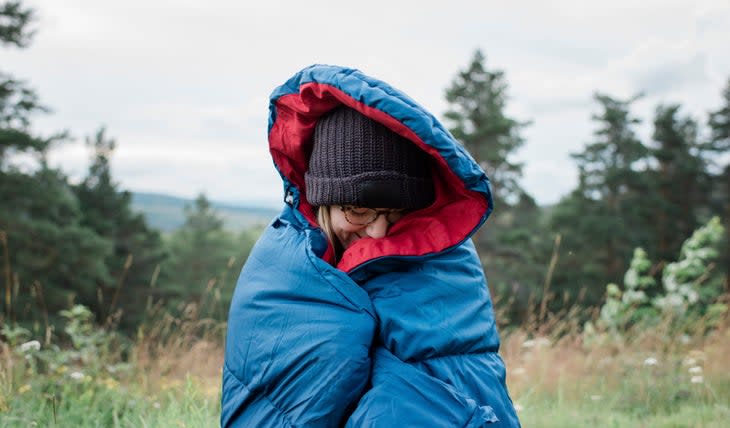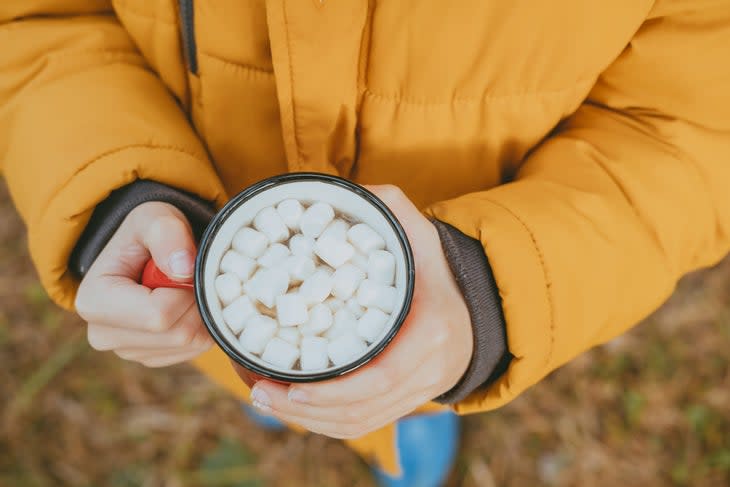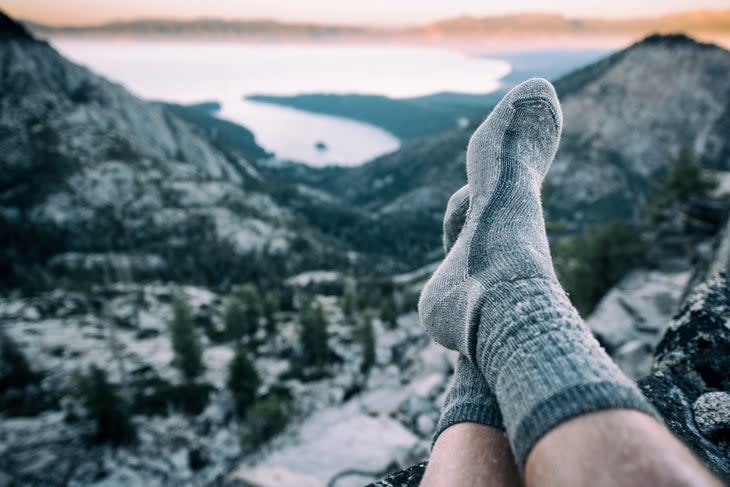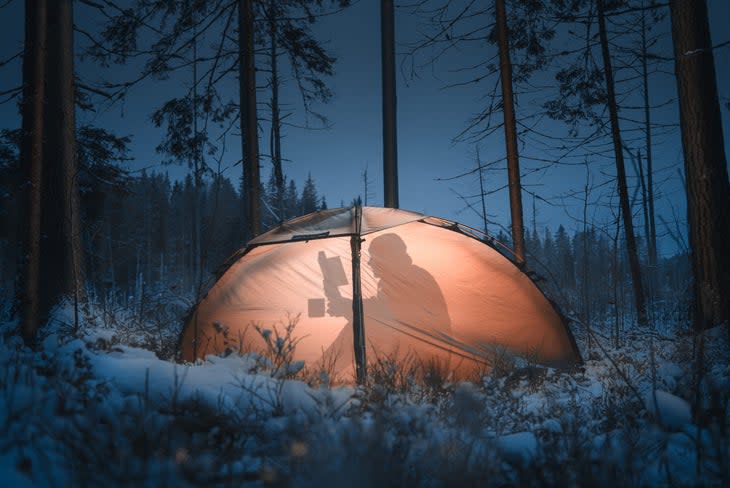Want to Make Your Next Hike Cozy AF? Embrace the Art of Hygge.
This article originally appeared on Backpacker
I love my backpacking buds, but route-finding isn't their forte. Nor mine. So in retrospect, it's not surprising that the "trail" we thought we were skinning to Peter Eiseman Hut in the shadow of Colorado's Gore Range was actually a set of random ski tracks leading to nowhere.
That's how I found myself bushwhacking along a ridge at 10 p.m. on a February night, staring holes into the conifer forest for signs of light and life. Four hours past the point of exhaustion, I caught the scent of woodsmoke; the hut was ahead. We staggered into the fire-lit living room in a fog of fatigue, and I fell onto a couch, shivering. I was still wearing my Scarpa touring boots, too weary to pull them off.
A few minutes later, an Irish lilt called me out of my coma: "Sure but you'd like a wee cuppa?" a Gaelic angel said, as she handed me a steaming mug of cocoa. Her smile could have melted glaciers.
Outdoor adventurers know the feeling well: A transition from hard boots to down booties, from cold wind to warm sleeping bag, from suffering to safety. The Danish have elevated it to a national obsession, in fact. They call it hygge, the Danish art of coziness and connection.
You’ve no doubt heard of the concept, put forward in endless hygge posts on Pinterest, and hygge appeals from the Danish tourism bureau. Fuzzy slippers. Firelight. Throw blankets. Steaming mugs. Purring kittens. Goose-down duvets. But hygge also applies to hardy outdoorspeople like you.
So says Meik Wiking, CEO of the Happiness Research Institute--my new dream job--in Copenhagen, and author of The Little Book of Hygge. As Saint Francis of Assisi was to asceticism, Wiking is to cozy.
"Hygge is about enjoying the simple moments in life," he says. "The ones that bring us feelings of gratitude, togetherness, pleasure. Hygge has often been associated with log fires, woolen blankets, and candles, however these should be seen more as mediators of hygge. Getting outdoors offers plenty of opportunities to enjoy those simple moments: the sounds of nature, the wind in our face, the view of the trees."
On my tortuous route to Eiseman I'd had enough of trees, their frozen sap creaking in subzero temperatures. (Or maybe I was hearing my own knee joints, hard to say.) But the hut was a temple of hygge: wood stove, warmth, friendship, and candles casting their magic. If all that cozy combustion doesn't burn down the hut, it'll be warming cockles for centuries.
Are your cockles, in fact, a bit chilly? Put these five Fs--all portable forms of hygge--in your backpack, and you'll maintain a hygge-glow wherever you wander this winter.

1. FNUG
That's the Danish word for fluff or fuzz, and residents of that country need plenty of both to help them through the wet, chilly, dark period between September and salvation (May). But that doesn't mean they're suffering; Denmark continually ranks among the happiest places on earth. Hygge gets them through, along with wrapping themselves in fnug. As Wiking puts it, "In Denmark, we say there is no such thing as bad weather, only bad clothes."
Kelvin Meeks, a senior material specialist with Marmot, advises that you to "think about snuggling in front of the fire--the classic hygge. Until the fire gets going, you need your cozy blanket. Once the fire's roaring, you might be cozy in a tee-shirt." Planning for outdoor cozy isn't that different. The trick is to stay flexible: cozy is the right amount of the right clothing for what you're doing right now. And you can pack to prepare for that.
He proposes this mnemonic to max out your fnug factor: Dress in TRP on your TRiP.
Transport--Your baselayer: A synthetic, wool, or wool-blend shirt that's soft, comfortable, and easy to move in, with quick-dry and wicking properties to move sweat away from your skin so it can evaporate. Cotton is the anti-fnug--clammy, clingy, cold.
Regulate--Lightweight fleece, stretch fleece, down, or synthetic insulated layering jackets have enough loft to hold body warmth, but they are breathable so you don't overheat.
Protect--Your shell keeps out rain and snow and wind. Breathability is also a benefit here. It should protect you without turning into a sweat terrarium.
HYGGEAR: Kelvin Meeks gets his fnug on with Marmot's WarmCube Active Alt HP Hoody. "It's light and warm for layering," he says. "It also works alone on cool days at moderate activity or on freezing days for high aerobic output like snowshoeing or trail running."

2. FLASK
I left the trailhead below the Mount of the Holy Cross in full sunshine and optimism. It was late September, the aspens were aglow, and the sky was the limit. But this being Colorado, the weather turned once we hit about 8,000 feet. As the graupel doinked off my skull, I became sullen and silent, and my buddy Dave grew concerned. "Peter," he said, "let's stop and have some cocoa."
Moments later his Svea was roaring, the water boiling soon after. When I brought the warm mug to my lips, hypothermia turned to happiness. His kindness warmed me as much as the hot drink did--another key lesson of cozy.
In The Little Book of Hygge, Meik Wiking writes: "Hygge is about being kind to yourself--giving yourself a treat, and giving yourself, and each other, a break from the demands of healthy living. Something sinful is an integral component of the hygge ritual. Especially if we all share the same bowl."
HYGGEAR: Last winter I skied near Colorado's Cameron Pass, where the Never Summer Range meets the Medicine Bow, to test insulated bottles for Backpacker. My favorite vessel from that trip: The Stanley Classic Trigger-Action Travel Mug, which can keep your hygge hot for up to seven hours. Add a nip of something sinful and share it with a friend for extra human warmth.
3. FEEL
Hygge has heart. According to the Oxford English Dictionary, the word is derived from the old Icelandic "hugga," which means to embrace or to soothe. If your down sweater is giving you a warm hug, you should hug it right back.
As Wiking writes in The Little Book of Hygge, "Letting your fingers run ... through the hairs of the skin of a reindeer is a distinctly different feeling from being in contact with something made from steel, glass, or plastic."
I haven't petted a reindeer recently. But I instinctively know that touch is important, like when I walk through L.L.Bean obsessively running my hands across the fleece, the sweaters, the ski socks. Now I know: I'm feeling for hygge, and you probably are, too.
"The human body doesn't know when it is 'comfortable,'" says Ray Davis, comfort and durability research associate for W. L. Gore & Associates. "That is a learned trait. You have trained your brain to associate the lack of discomfort as being comfortable. So when you are shopping for gear, eliminate potential non-thermal factors of discomfort before you proceed to checkout."
He's talking about fit, functionality, stiffness, weight--even the noise a zipper makes, or the swishing sound of arm friction when you walk. (You can't unhear some things!) According to Davis, these psychological factors add as much to comfort as the loft of the insulation.
For maximum hygge, you must actually visit the outfitter, rather than just clicking through your gear list online. "Pick up the garment, feel it, wear it, stretch, and move around in it for a few moments in the store," Davis advises, nerding out on cozy. "Assess your ergonomic and sensorial comfort."
HYGGEAR: Backpacker gear testers assessed their ergonomic and sensorial comfort in various puffies, while preparing for the winter of 2022-23. Their hyggeligt (adjectival form of hygge) pick: "The Rab Mythic Ultra removes the usual trade-off between warmth and packability. Thanks to a generous amount of 900-fill down in offset box-wall baffles, as well as a heat-reflective aluminum scrim (think gauze, but with the ability to bounce body heat back at you), the Mythic Ultra was warm enough to be one tester's go-to ice climbing belay jacket in the White Mountains of New Hampshire, even on zero-degree days." If I was single, I'd marry that jacket.

4. FEET
For want of a nail the shoe was lost.
For want of a shoe the horse was lost.
For want of a horse the rider was lost.
For want of a rider the battle was lost.
For want of a battle the kingdom was lost.
And all for the want of a horseshoe nail.
Swap in "sock" for "nail," "foot" for "shoe," and "hygge" for "horse," and you get the picture: If your feet are miserable, the backpacking battle is lost.
Owen Rachampbell is a product line manager for Darn Tough--a kind of in-house expert on all things cozy. Not surprisingly, he sees hygge as a sock thing: "Your feet are not going to be happy if you are wearing a crappy pair of socks."
Rachampbell thinks everything from the shins down is a system, and merino wool makes it run optimally. His logic: "Sheep have been hiking and running in wool for 10,000 years. Synthetic fibers cannot beat this track record."
Darn Tough engineers comfort with soft, wicking, and anti-stink merino wool up top, merino "terry loops" to cushion the foodbed, and spandex to keep from rubbing you raw. Rachampbell alternated two pairs of Darn Tough while through-hiking the AT, and he claims his dogs never barked. Your feet are constantly in motion in your boots. Socks can wander, stretch, bunch, and slouch. Buy a pair that will hug your feet, not hurt them.
A further tip from Wiking, to warm you from your soul to your extremities: Associate gear purchases with a happy event. Go sock shopping when you schedule that much-anticipated snowshoe adventure with friends, or just before you take the correct trail into Eiseman hut. Elevated emotion + elevated gear = hyggemotion, which is the best kind of warmth.
HYGGEAR: Rachampbell cites a notoriously cold-footed woman (know anybody like that?) for his sock recommendation: "My wife swears by our Mountaineering socks for chillier nights on the trail or even at home." We also love pairs from Smartwool, Kora, and Swiftwick. Just remember: Try before you buy.

5. FIRE
Much of the mountain west will enforce fire bans next summer, so the classic hygge campfire may be on the way out. But there are other ways to kindle warmth without it.
"In its more contemporary usage," Wiking writes, "'hygge' emerges in nineteenth-century Danish literature as part of a more integrated sense of community and belonging, especially following the Prussian-Danish wars in 1848 and 1864." I have no idea what those dastardly Prussians were up to back then, but the point is clear: There's real warmth in camaraderie, so you can produce it even if your matches are wet.
Wiking identifies the ten key factors for hygge as atmosphere, presence, pleasure, equality, gratitude, harmony, comfort, truce, togetherness, and shelter. Alpenglow can supply that, as can your attitude when it's time to filter water for dinner. And what my hiking buddies lack in map skills, they make up for in lightweight guitars and singing. Friendship has been the best part of backpacking for me, and it's at the core of the Danish art of cozy.
Wiking defines the hygge hiker as "one who is intentional about how they enjoy the now and make the best of it." Or to put it proverbially: It's better to light a candle than to curse the darkness.
HYGGEAR: "No recipe for hygge is complete without candles," says Wiking. "When Danes are asked what they most associate with hygge ... 85 percent will mention candles." The UCO Original Candle Lantern is designed to operate safely in a tent, and can even help to heat it. All that, and the glow is blissful--the very essence of hygge.
Be cozy out there.
Peter Moore, the former interim editor of Backpacker, is a contributing cartoonist to the Colorado Sun, and he posts other fun/weird/adventurous stuff at petermoore.substack.com.
For exclusive access to all of our fitness, gear, adventure, and travel stories, plus discounts on trips, events, and gear, sign up for Outside+ today.

